12 Primate Ecology
Michelle Field
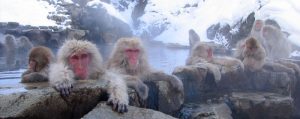
Primate ecology is the study of the relationship between primates and their environment. Their environment includes not only the physical environment, e.g., trees, water, weather, but also the other animals in the environment, including other non-human primates and even humans.
Why should we care about primates and their ecology? Remember that evolution is always environmentally dependent, so the environment is the main thing that we have to consider when examining a primate, its biology, and behavior. Also, keep in mind that primates are not only affected by their environments, they affect their environments as well (by eating plants and insects, dispersing seeds, etc.).
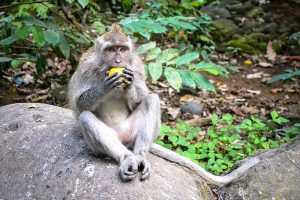
There are two primary environmental factors that primate ecologists focus on:
1) Food
Primatologists, scientists who study primates, examine the quality, quantity, and distribution of food in a primate’s environment.
Why? Because food equals babies. This means that those individuals who acquire more high-quality food more efficiently are likely to have more offspring and therefore will be more evolutionarily successful.
This pressure is greater for females than for males, because of the biological costs associated with reproduction (reproductive asymmetry). Remember that primates spend a very long time as dependent nursing infants, so primate mothers have a heavy burden when caring for them (the only exceptions are some New World monkeys: the father cares for the infants, but the mother still nurses them).
2) Predators

Primatologists also examine the types and distribution of potential predators in a primate’s ecosystem. Why? Because no one wants to get eaten, right? Those who can most efficiently and effectively avoid predation are likely to have more offspring and therefore will be more evolutionarily successful.
Primatologists also look at other environmental factors, such as:
- weather
- the distribution of water
- the distribution of sleeping sites, and
- the primate’s relationships with other individuals within their social group, other groups of their own species, and other species (including humans).
Food
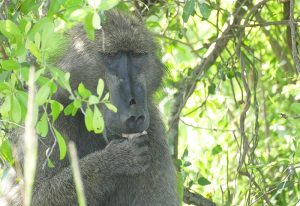
Most primates are herbivores (they eat plant foods) and are fairly generalist in their dietary habits. Some primates are omnivores and eat lots of things (plants and animals).
However, some primates are more specialized.
- Folivores: eat mainly leaves.
- Frugivores: eat mainly fruit.
- Insectivores: eat mainly insects.
- Gummivores: eat mainly tree sap.
- (Facultative) Carnivores: eat mainly meat.
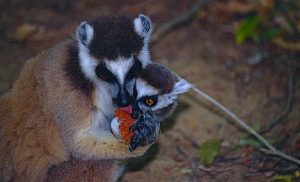
One of the challenges that primates face in their day-to-day life is a type of evolutionary arms race they have with their food. Some food items, like fruit, “want” to be eaten. In other words, it’s evolutionarily advantageous for a fruit to be eaten by a primate, who then carries the fruit’s seeds far away from the parent plant in its stomach, to deposit them elsewhere. The fruit benefits from this seed dispersal, thereby limiting competition between the parent plant and its offspring. This is one of the hypothesized reasons that fruits have high sugar or fat contents, to make them attractive to seed dispersers, such as primates and birds.
However, some food items, like leaves, don’t “want” to be eaten. It’s not evolutionarily advantageous for a plant to be stripped of its leaves. A leafless tree would not be able to perform photosynthesis and would promptly die. This is why plants have developed certain chemicals, called secondary compounds or antifeedants, in their leaves. These chemicals make the leaves unpalatable or indigestible to primates. In these cases, scientists have determined that primates have developed behavioral methods to avoid consuming antifeedants. For example, most leaf-eating monkeys prefer to eat young leaves, which are visually identifiable (either lighter in color or a different color) and higher in nutrients and lower in indigestible fiber and antifeedants, than mature leaves.
Not only have primates developed behavioral strategies to meet these challenges, some primates have evolved different types of color vision in order to forage for food and other primates have developed specialized digestive systems to deal with low-quality (high-fiber, high-antifeedant) foods.
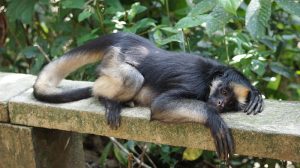
Activity budgets
How a primate spends its time is called its activity budget.
These are comprised of the major categories of:
- foraging/feeding
- resting/sleeping
- locomotion/traveling, and
- social behavior
Why should we care about activity budgets?
Examining a primate’s activity budget gives primatologists a good idea of how that particular primate (or primate group) “makes a living”. For example, if squirrel monkey (pictured right) Group A spends 30% of its time foraging and squirrel monkey Group B spends 40% of its time foraging, then one can assume that there is something going on that is causing the difference. One can form possible hypotheses such as: Group B is larger than Group A and has more mouths to feed and therefore has to spend more time looking for food to feed them OR Group B has less food in its area than does Group A and so has to spend more time searching for it.
Remember also that if a primate has to spend more time eating or moving around in order to find something to eat, then they are having to spend less time either resting or socializing. Primates only have a finite amount of time in their day, so they have to maximize the use of it the best they can within their environmental parameters.
Activity budgets denote when a primate is “making a living”:
- Diurnal: active during the day. Most primates are diurnal.
- Nocturnal: active during the night.
- Crepuscular: active during dawn and dusk. Ring-tailed lemurs (pictured below) have this activity pattern.
- Cathemeral: active during irregular periods during day and night. Black lemurs (pictured below right) are one of the few primate species who have this activity pattern.
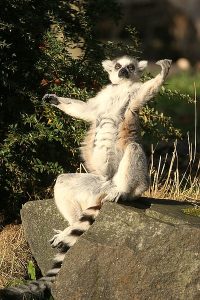
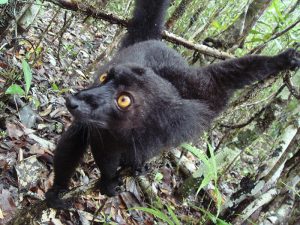
Note that these activity patterns are not hard and fast rules. As with diet, there is a lot of variation in how flexible a particular species (or group within a species) is when it comes to their activity patterns. For example, although traditionally thought of as strictly nocturnal, the activity patterns of owl monkeys have been found to be highly sensitive to environmental factors such as temperature and amount of moonlight.
Food and feeding competition
One of the main factors that affects a primate “making a living” is feeding competition (competing with others for food).
There are two groups that a primate competes with;
- the other primates in its social group (AKA within-group competition)
- primates (of the same species) in other groups (AKA between-group competition)
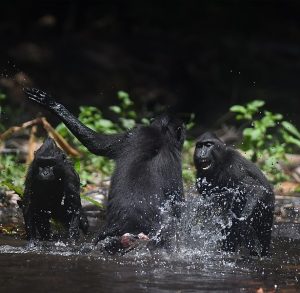
There are also two types of competition. The type of competition prevalent in a situation depends on the quality and quantity of food available in the environment.
Scramble competition: happens when there is a lot of low quality food. This is more common for leaf-eating primates, because trees tend to have large quantities of edible leaves (although some types, such as young leaves, may be preferable to others). It’s an indirect competition in which whoever finds food faster or eats faster gets more food than do other individuals.
Contest competition: happens when there is a small amount of high quality food. This is more common for fruit-eating primates, because a fruiting tree has a limited amount of high-quality fruit. It’s a direct competition, where certain individuals (stronger, higher social status) get more food than do other individuals via squabbling or fighting.
In total, one can have:
- within-group scramble competition
- within-group contest competition
- between-group scramble competition, and
- between-group contest competition.
Feeding competition can be severe and have serious effects on the health, well-being, and reproductive capacities of primates. In other words, it has a direct effect on their evolutionary fitness. As expected, primates demonstrate a lot of behavioral strategies to deal with the feeding competition they face. For example, a group with high scramble competition may spread out more when feeding so as to access more resources OR in a group with high contest competition, some individuals may form coalitions in order to “gang up on” other primates to take their food.
Spatial use: home ranges and territories
The area that a primate uses is its home range. The part of the home range that’s used most often is the core area. Some species, such as snub-nosed monkeys, have very large home ranges (32 sq. km) and other species, such as the pygmy marmoset, have very small ones (0.003 sq. km). A primate’s home range has to contain all of the resources it needs in order to survive (food, water, sleeping sites, etc.). The home ranges of different primate groups often overlap, sometimes only a little, but sometimes a lot. If the home range is physically defended, it’s a territory. Chimpanzees are famous for their territorial conflicts, which are so organized and violent that scientists have begun calling it “warfare“. You can watch chimpanzees patrolling their territory here.
Cite this page
APA Style: Field, M. 2022. Primate ecology. In T. M. Saneda & M. Field, Biological Anthropology: a brief introduction. Cascadia College Pressbooks.
Chicago Style: Field, Michelle. 2022. “Primate Ecology.” In Biological Anthropology: A Brief Introduction, 3rd. Bothell, WA: Cascadia College Pressbooks.
CSE Style: Field M. 2010. Primate ecology. In: Biological Anthropology: a brief introduction, 3rd ed. Bothell (WA): Cascadia College Pressbooks. [modified 2022; accessed 2022 Dec 5]. https://openwa.pressbooks.pub/anth205bioanth/chapter/primate-ecology.

